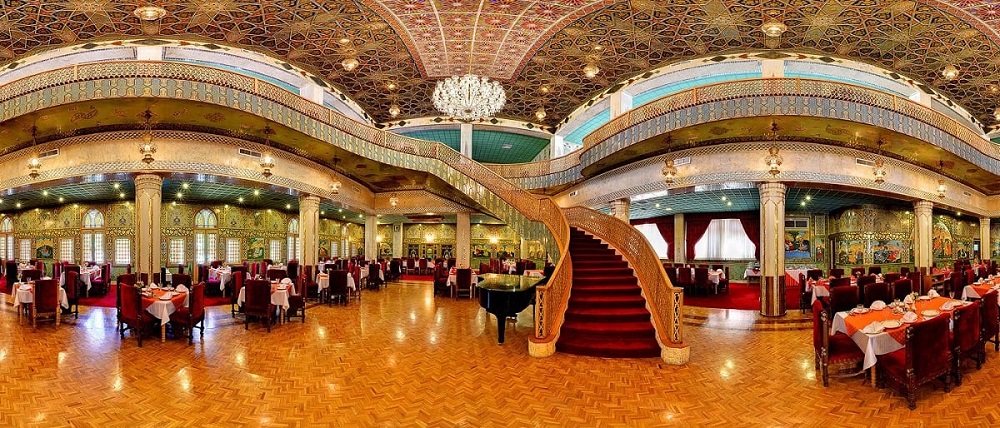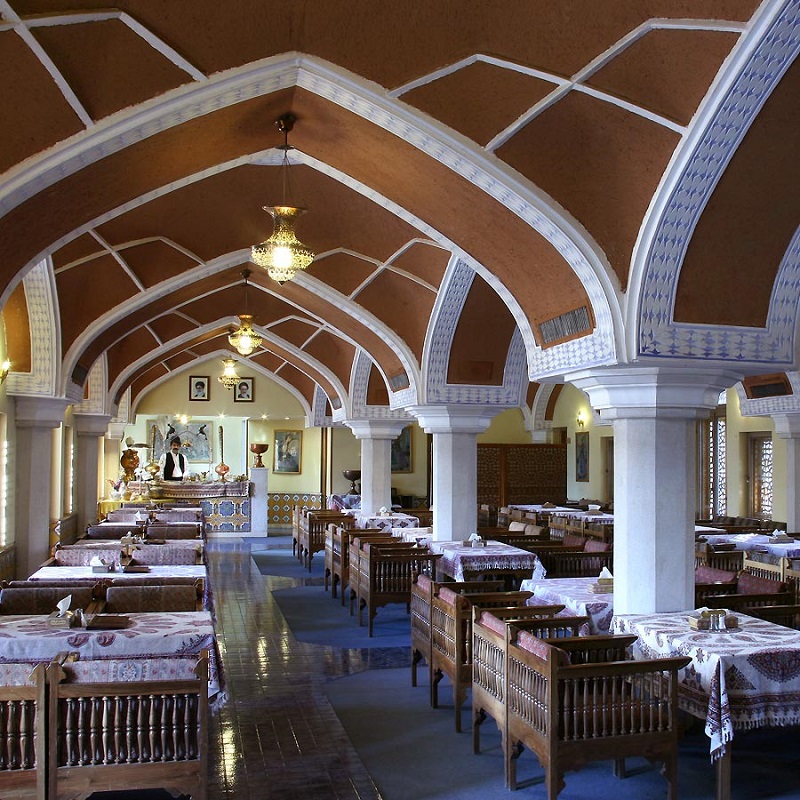Abbasi Hotel Introduction
The Safavid era is a glorious age of architecture with greatness and stunner in Persia. When Shah Abbas I chose Isfahan as his capital, he decided to adorn Isfahan so that merchants and tourists would be thrilled while seeing it. During this period, the city of Isfahan was so marvelous that it was called half of the world. Abbasi Hotel or Shah Abbasi Hotel is one of the most exquisite hotels in the Middle East, had built by order of Shah Sultan Husayn Safavid, and is known as the caravanserai of the Shah’s mother. It is considered one of the most valuable works of the Safavid era; furthermore, in 2017, the hotel was named the most beautiful hotel in the region.

Shah Abbas Hotel History
By flourishing of Persia’s economy during the Safavid rule, constructing colossal and beneficial buildings such as bazaars, bridges, dams, reservoirs, pigeon towers, mosques, and schools had become prevalent. But the most significant buildings were caravanserais that can still be seen in this land, whether along the roads or in the corners of cities. The caravanserais were not only a place for caravans and passers-by to spend the night but also a suitable one for docking and loading caravans as well as goods storing and trading exchange. Chardin, a European traveler who visited Isfahan during the Safavid period, enumerated Isfahan’s caravanserais more than 1,800. Among the surviving architectural works from that era, the school complex, bazaar, and caravanserai have survived, which shines like a unique gem beside Chaharbagh Street in Isfahan. This complex was built by order of Shah Sultan Hussein, the last Safavid king; since he gifted it to his mother, at that time, it was called the school and caravanserai of the king’s mother.
You can see an astonishing hotel in Isfahan near Chaharbagh Street, on Amadegah Street, among sightseeing and commercial centres such as Hasht Behesht Garden and Art Bazaar. A residence with a long history, known as the Abbasi Guest House. As the oldest hotel in the world, it is a magnificent building, a lasting heritage of the Persian art and architecture manifestations with a world of beauty that cannot be described in words.
Abbasi Hotel Architecture
Shah Abbas Hotel Architecture Introduction
The architecture of the Abbasi Hotel or the Mother Caravanserai is very similar to Naqsh-e Jahan Square, just a smaller version. In addition, same as other buildings built during the Safavid period, its architecture placed great emphasis on detail designs.
The architectural style of Abbasi Hotel is Safavid, and part of it is Qajar. Its architectural plan is four porches, and there are two-story rooms on each porch. It may be interesting to note that, contrary to public belief, according to Tavernier, a European traveler, wealthy merchants of that time preferred the lower rooms as they were cooler in summer and closer to their barns and docks. There was a lengthy stage in the central courtyard of the caravanserai for unloading loads and several stables for treating the animals. The north porch of the caravanserai had an entrance to the royal bazaar, and the south porch to the garden of Fatehabad, unfortunately, none of which remains today.
Abbasi Hotel Architecture History
The prosperity of the Safavid era did not last and was plundered by the Afghan invasion. In later years, the Madarshah Caravanserai or the Abbasi Hotel, like many other buildings, was abandoned and only repaired once during the reign of Zell-e Soltan, the Qajar prince.
In 1957, the Iran Insurance Company took a step forward, at the suggestion of André Godard, who was once head and then adviser to the General Directorate of Archeology, approved the conversion layout of the inn into a guest house which later was called Shah Abbas Guesthouse. By implementing the layout, not only a valuable historical monument was saved from destruction, but also the memory of its initial usage as the residence of travelers and tourists was revived in the new form of an inn. Moreover, a distinguished atmosphere was created in the remarkable Persian city, Esfahan.
Abbasi Hotel Reconstruction
Two goals were considered in the inn’s reconstruction: preserving the originality of the exterior facade and transforming the caravanserai rooms into guest rooms. First, the walls and ceiling were rebuilt, then the damaged components were restrained and molded, and the raw clays were swap with brick or concrete. Now, in the luxurious rooms on the north side, a complete and almost intact example of the thick walls and arches of the famous arches, fountains, niches and ledges of three hundred years ago can be seen. In the reconstruction, has tried to keep the doors and windows in their former style and appearance. Whatever needed to remodel, became rebuilt. Such a magnificent and luxurious hotel has been serving travelers since 1966.
The management of such a guest house was full of sense: for this purpose, after much study, the management selected Negresco Hotel Group from France, which was responsible for two years. Then, the owner of the guest house trusted Iranian managers.
The name of Shah Abbas Hotel changed to Abbasi Hotel in 1979. Today, the splendor and attractiveness of such an impressive hotel have become famous globally.
Abbasi Hotel Style
In the desert and semi-desert climate of Iran, the courtyard is the beating heart of architecture; The courtyard of the Abbasi Hotel is adorning with colorful gardens and flowers and a small stream called “Farr-e Shadi” flows through them.
Abbasi Hotel Rooms
Shah Abbas Hotel consists of 3 floors with 225 rooms such as campus, Safavid, landscape, and standard rooms. In addition, the Qajar Suite of Abbasi Hotel and Pardis Suite of Abbasi Hotel, which all embrace hugely distinctive architecture, presents a dreamy and imaginative atmosphere.

Abbasi Hotel Halls
The Abbasi Hotel halls are the most prominent part of the hotel, which present the Persian artists’ profession. The halls encompass a complete collection of Persian Islamic art and architecture elements with impressive decorations and design.
The Golden Hall of Abbasi Hotel
The golden hall, which shines with its engraved gold sheets on the green-blue background of the walls, is only a corner of Persian artists’ artwork with its gilding, laminating, and ceiling plastering. The harmony of the green ceiling and the walls, carpets, and chandeliers has doubled the hall attraction.
The Ali Qapu Hall in Shah Abbas Hotel
The Ali Qapu Hall has been inspired by Ali Qapu Palace and its music room so that entering the hall, you will stare at its marvellous ceiling. One of the main elements of the hall decoration is Tongbari, in which there are flagon shapes created on the ceilings and walls, depended on the designer’s abilities. The design perfectly represents itself in the Ali Qapu Hall. Tongbari is not only the hall decoration but also the moldings, paintings, and stringcourse that have made Ali Qapu Hall one of the architectural masterpieces of recent centuries in Iran.
Master Chaichi has built the entrance door of this small hall, which opens to the entrance hall of Chehelstoun Restaurant. The door is made of old walnut wood and has decorated with Islamic motifs.
The Abbasi Hall
Abbasi Hall is one of the most brilliant halls in the complex. You can watch the miracle of Isfahan artists’ fingers on the roof and body of the entrance hall, which is decorating with the art of Copbori and the lay-up technique. The repeated and uniform patterns of the walls and ceiling, covered with gold sheets, depict the glory of art and design in the building. Inside the hall, the wooden Muqarnas on the ceiling and various delicate Tongboris create a circle of color and light above the guests’ heads. The gold sheets engraved on the walls and ceiling also make the hall dazzling and eye-catching.
The Mirror Hall (Ayeneh Hall) in Abbasi Hotel
Locating on the ground floor, the Mirror hall entrance opens to the restaurant hall. There are light green walls with the most dazzling models worked on the mirror such as gilding, lamination, Khataei designs of Safavid also molding works. Interesting to know, twenty thousand Hindi gold sheets have applied for the hall gilding and lamination. The walls and ceiling are covered with gold sheets to maintain radiance and do not darken over time. These gold covers are engraved as well.
The Naqsh-e Jahan Hall of Shah Abbas Hotel
Naqsh-e Jahan hall, located on the ground floor, is the most captivating one for visitors; it contains the magnificent ancient inscription, and special trelliswork (Gereh Chini) on doors and windows, besides colorful glass that amazingly reflects the light. The warm colors used throughout the hall bring indescribable calmness.
The Turquoise Hall (Firouzeh Hall) of Abbasi Hotel
The turquoise color placed on a background of gold sheets seems to have created the most artistic and spectacular wallpaper in the world for the Turquoise Hall. The art of Copbari here has blended with the art of painting, mirror work, and molding in the hall, creating a unique combination. Turquoise convex mirrors with embossed designs and artistic details are also show off alongside the gold sheets on the walls. The railings and distinctive interior design enhance the hall’s beauty, besides turning there into a suitable space for throwing parties, banquets, and side exhibitions of conferences.
The Marble Hall (Marmar Hall) of Shah Abbasi Hotel
The next hall is the Marble Hall; The art created on the ceiling, the delicate mirrors, and the color matching of the marble floor stones with the walls and other details have made this hall one of the most glittering halls in Isfahan.
Abbasi Hotel Chehelston Hall and Restaurant
Stepping into Chehelston Hall, you will feel the magnet of glory and elegance. Chehelston restaurant with its ornaments shows another manifestation of Safavid and Qajar era architecture. There are two painting styles in both Safavid and Qajar’s. The appearance of the restaurant’s roof has the same trelliswork as the wooden trelliswork on the ceilings of the Chehelston porch but has done with molding and paintings. Darius design chairs inspired by the Great Darius stone chair in Persepolis, the art of walls and ceiling, columns, fences and floors, doors and glass, and even lights and ceiling pendants, duplicate the grace in the middle of such a hall.
Other Restaurants and Cafes of Shah Abbas Hotel
Other attractive sections of the Abbasi Guest House include the breakfast salon, the Naqsh-e Jahan cafeteria, the traditional dining room, the traditional tea house, and the panorama restaurant, each of which hosts guests with a refreshing and distinctive atmosphere.
The prominent decorative elements of the breakfast hall are Tongbari, plastering, gilding, beside pale colors.
The murals at the cafeteria, which depict a mixture of original Persian art with pleasant colors, will absorb you.
The traditional dining room at the end of the hotel garden, on the east side, includes a brick roof detailed with simple plastering, which next to the traditional chairs and beds, provides a calm and cozy ambiance.
There is a traditional tea house on the north side, the tiles of which, the brick facade of some of the walls, and the two-story porches will dazzle your eye.
There is also an open-air restaurant on the hotel’s rooftop called the Cheshmandaz Restaurant (Panorama Restaurant), offering a 360-degree view of the city.


